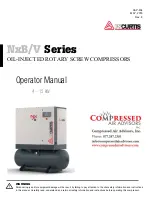
7
HP01P006SS man v.170807
Silent Air Series
substances are spilled, clean up immediately.
8.
When checking or when refilling air line anti-
icer systems with antifreeze compound, shut
off compressor and allow it to cool. Keep
sparks, flames and other ignition sources
away and DO NOT permit smoking in the
vicinity.
9. Stop compressor and disconnect power if a
hazardous condition arises.
10.
Wear snug fitting clothing and confine long
hair when around compressor. Keep all body
parts and clothing away from couplings,
flywheel and other moving parts of the
equipment.
Keep all persons away from the
discharge opening of hoses or
tools or other points of
compressed air discharge. If the
machine is installed in an
enclosed area, be sure to vent
the relief valve outside of the structure or to an
unoccupied area.
Always make sure main power is
off before touching moving parts
of compressor.
11. Never exceed the pressure rating of any
component in system.
12. Protect material and air lines from damage or
puncture. Keep hose and power cable away
from sharp objects, moisture, chemicals, oil,
etc.
13. Check condition of hoses before each use.
Do not use a damaged hose. If hose is
damaged, replace immediately.
14. Read, understand and comply with all warning
labels on unit.
15. Drain tank of moisture after each use.
If compressor is not to be used for extended
periods of time, leave tank drain valve open to
allow moisture to completely drain from tank.
16. Do not tamper with Safety Valve. The
Safety Valve is factory set for your model air
compressor. Any user adjustments to Safety
Valve will automatically void warranty.
17. Air compressors get hot while in operation.
NEVER touch the motor, the
discharge tubing or compressor
pump while in operation.
18.
The compressor turns itself on and off
automatically while the pressure switch is
turned on.
19. The air pressure switch is set at the factory
for optimum performance of your equipment.
Never attempt to bypass or remove this switch
as serious damage to equipment or personal
injury could result from excessive air pressure.
20. Compressed air from the unit may contain
carbon monoxide. Air produced is not suitable
for breathing purposes.
21. Always use a respirator when spraying paint
or chemicals.
Air Tool Cautions
1. DO NOT use air tools that are rated below the
maximum rating of the compressor. Select
air tools, air hoses, pipes, valves, filters and
other fittings accordingly. DO NOT exceed
manufacturer’s rated safe operating pressures
for these items.
2. Make sure all hose connections are
adequately secured to prevent tools or hose
ends from being accidentally disconnected.
3. Remove adjusting keys or wrenches before
turning the tool on. A wrench or key that is
left attached to a moving part of the tool may
result in personal injury.
4. Keep work area clean and well lit.
Cluttered or dark work areas invite accidents.
5. Keep children away.
All children should be kept away from the work
area. Never let a child handle a tool without
strict adult supervision.
6. Store idle tools out of the reach of children and
untrained persons.
Tools may be dangerous in the hands of
untrained users.
7.
Do not operate any tool if under the influence
of alcohol or drugs.
Read warning labels on prescriptions to
determine if your judgment or reflexes are
impaired while taking drugs. If there is any
doubt, do not attempt to operate.
8. Do not force tool.
Use the correct tool for your application. The
correct tool will do the job better and safer at
the rate for which it was designed.
































